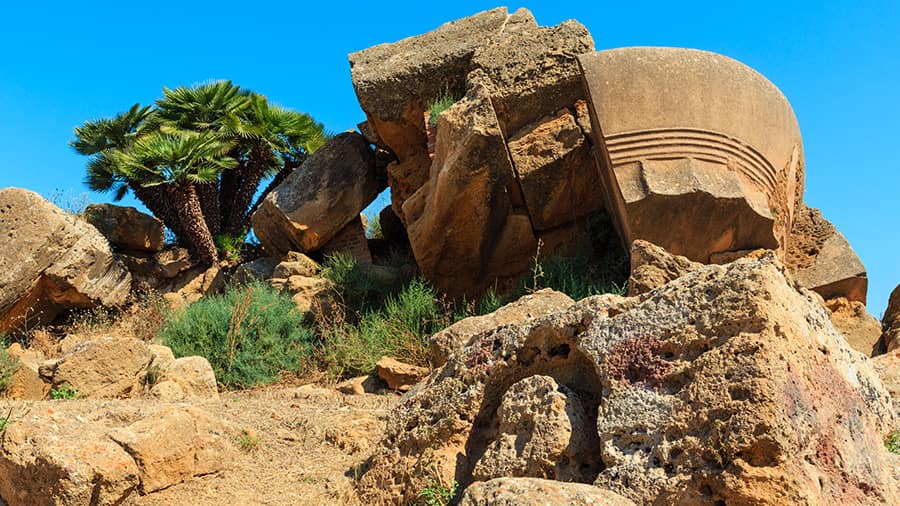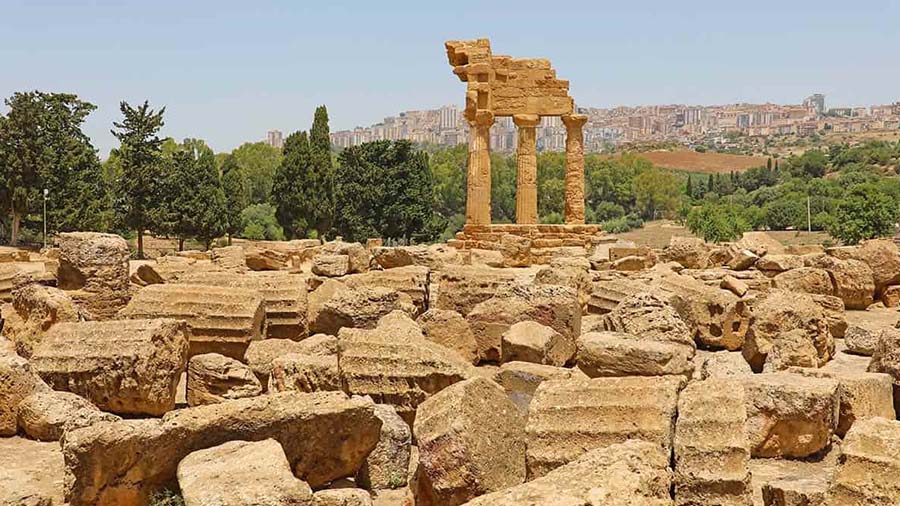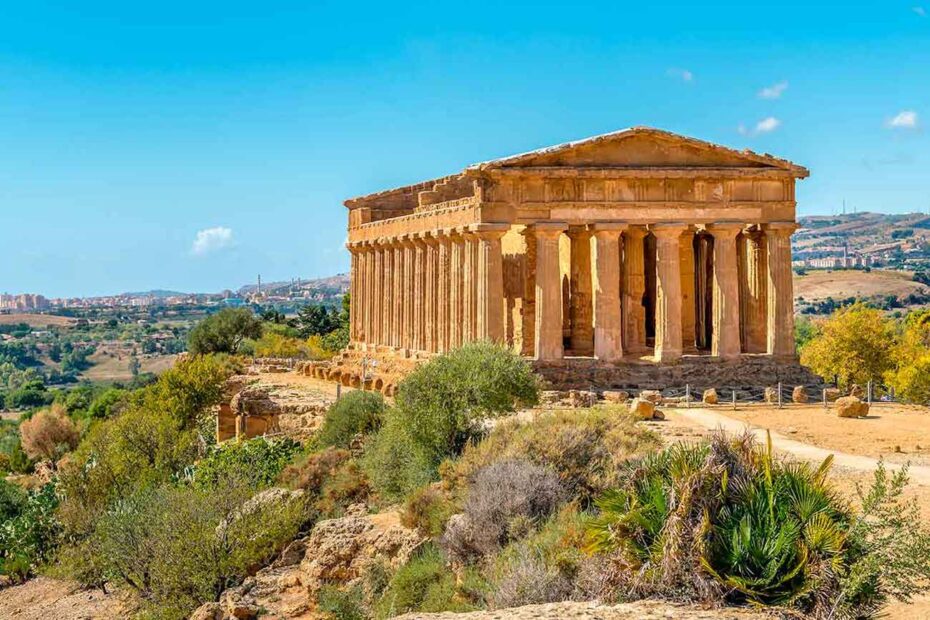The Valley of the Temples in Agrigento is one of the most important archaeological sites in all of Sicily. Its 1,300 hectares make it one of the largest archaeological parks in the Mediterranean and since 1998 it has been part of the Sicilian World Heritage. Inside are the remains of religious and civil buildings of Akragas, the ancient city of Agrigento. In addition to the important archaeological testimony, the park is also the custodian of an extraordinary natural heritage and landscape. In the area called the Garden of Kolymbrethra is a small paradise on earth with citrus trees, almond trees and dense Mediterranean scrub. Near the Temple of Hera and the Temple of Concord, as well as within the Kolymbrethra, are centuries-old olive trees.
The monuments of the Valley of the Temples in Agrigento
The Temple of Hera Lacinia or Juno

A visit to the Valley of the Temples in Agrigento begins with the Temple of Juno, also known as the Temple of Hera Lacinia. Actually, as with most temples, we do not know to whom it was dedicated. The attribution to Hera Lacinia came from a misinterpretation of a text by the Roman writer Pliny the Elder, which actually mentions a temple located in Calabria, in Crotone. The Temple of Juno dates back to the fifth century B.C. It is Doric in style, peripteral, with columns along the entire perimeter, and hexastyle, with six columns on the short side. It has undergone several restorations over the centuries, most probably in Roman times after being burnt down by the Carthaginians. Its current appearance is the result of an anastylosis work carried out in the 18th century, when the columns on the north side were raised.
The Southern Walls of Akragas

Walking along the Via Sacra, the straight road from the Temple of Juno to the Temple of Concordia, you will come across the remains of the southern wall of the city of Akragas. It extended for about 12 kilometers and had a quadrangular plan. It followed the natural conformation of the terrain and was therefore made up of sloping sections of rock alternating with blocks of calcarenite. Nine gates opened along the perimeter, always in a valley or a slight natural depression. The construction of the walls dates back to the 6th century B.C., but around 339 B.C. several restorations were carried out. Until the years before, in fact, there was a treaty in force between Syracuse and Carthage that required the maintenance of the city of Akragas without fortifications. Excavated in the walls, some Christian arcosolium burials are also visible. They are so called because of the presence of a semicircular niche above the burial ark.
The Temple of Concordia

Continuing our visit to the Valley of the Temples in Agrigento, we come to the symbolic monument of the entire archaeological park: the Temple of Concordia. It is so called because in the 16th century the historian and theologian Tommaso Fazello linked the temple to a Latin inscription found nearby. The temple dates from the fifth century B.C., is Doric in style and is peripteral and hexastyle. Although it was built at the same time as the temple of Juno, the latter is in a better state of preservation. This is due to its transformation into a Christian basilica in the late sixth and early seventh centuries B.C., dedicated to Saints Peter and Paul. As in the case of the Cathedral of Syracuse, structural changes were made to the building to adapt it to its new functions, which in fact preserved its structure. In the 18th century the temple was restored to its original appearance as we can admire it today.
The routes of the Hellenistic-Roman Quarter and the Necropolis
Arriving at the area of the Temple of Concordia, two different free routes start. The first leads to the so-called Hellenistic-Roman quarter and takes about an hour and twenty minutes. The second leads instead to the early Christian necropolis and takes about an hour. A little further south is another necropolis, the Roman or Giambertoni necropolis. If you are not interested in these detours, the next stop on your visit to the Valley of the Temples in Agrigento is the Temple of Heracles.
The route of the Hellenistic-Roman Quarter
A long straight route will take you first to the Greek Theater of Akragas, which was discovered during an excavation campaign in 2016, and then to the Hellenistic-Roman Quarter. This is an area of about 15,000 square meters. The excavations, which were carried out in the 1950s, unearthed twenty-seven dwellings with magnificent mosaics and decorations, as well as some commercial buildings such as sales counters, warehouses and wells. The first residential nucleus is a Greek quarter built around the 4th century B.C. according to the dictates of the urban planner Hippodamus of Miletus. On top of this urban layout is the Roman quarter, built by extending and modifying the existing dwellings around the 2nd and 3rd centuries BC. Some of the villas still visible today have magnificent mosaics. In the House of the Swastikas, the House of the Gazelle and the House of the Master of Abstraction there are real mosaic carpets with geometric, plant and zoomorphic motifs.
The Paleochristian Necropolis of the Valley of the Temples in Agrigento

The route to the Paleochristian necropolis of the Valley of the Temples begins by crossing the so-called Vie dei Sepolcri of Agrigento. This is an ancient canal of Greek origin that, after being abandoned, became a road. The tombs found here are both stone sarcophagi and formae tombs, that is, trapezoidal tombs dug into the rock. Continuing along the path, we come to the sub divo necropolis, an open-air necropolis. Here, too, there are about 130 formae-type tombs and the necropolis extends to one of the entrances to the Fragapane Cave. This is the largest catacomb found in Agrigento and was created by reusing two ancient water cisterns from the Greek period. Inside there are cubicula, that is burial chambers, arcosoli and floor burials. The itinerary ends with a visit to the garden of Villa Aura, where there are two different hypogea, also made from two ancient Greek cisterns.
The Giambertoni Necropolis and the Tomb of Theron

Leaving the cave of Fragapane and going to the left, we come to the Roman Necropolis, also known as the Necropolis of Giambertoni. It is a Roman cemetery dating from the 1st to the 3rd century A.D., which extends beyond the walls of Akragas. The tombs are “chest-like” in limestone. Monumental tombs were also part of this cemetery, some of which are still visible, such as the so-called Tomb of Theron. This is a small Roman funerary monument from the Hellenistic period, consisting of two overlapping parts. At the base is a square podium built with square marble blocks. At the top there is a temple with a cubic frame. From the necropolis of Giambertoni also come a number of carved Roman sarcophagi. Among them is the splendid sarcophagus of a Child, kept in the Pietro Griffo Archaeological Museum.
The Temple of Heracles or Hercules

The Temple of Heracles (Hercules to the Romans) is the oldest of the temples in the Valley of the Temples in Agrigento. In fact, the considerable length of the temple, the large diameter of the columns and the conformation of the capitals allow to date the construction of this sanctuary to the late 6th century BC. References in the works of Titus Livy and Cicero allow the attribution of the cult of Heracles to this temple. Both also refer to a bronze statue that was kept in the sanctuary and worshipped by the population. The temple, in Doric style, is peripteral and hexastyle. Inside, the presence of pronaos, naos and opisthodomos are evident. The roof of the temple of Heracles was decorated with a series of eaves in the shape of lion heads. Archaeological excavations have unearthed two different sets: one from the late 6th century BC and the other from the first decades of the 5th century BC.
The Temple of Zeus Olympius

Continuing our visit to the Valley of the Temples, we come to the ruins of the Temple of Zeus Olympius. The people of Agrigento had this temple built to thank the father of all the gods after the city’s victory in the Battle of Imera in 480 BC. The sanctuary was of unusual size, and sources of the time describe it as the largest Doric temple in the West. Its construction inspired Greek architects to experiment and find innovative architectural solutions. The most interesting is that of the Telamons, statues of male figures used in place of columns to give greater stability to the structure. The one visible in the temple ruins is a cast made in the 19th century. To see a reconstruction of one of the original Telamons, it is necessary to go to the Archaeological Museum of Agrigento.
The Sanctuary of the Chthonic Deities

The Sanctuary of the Chthonic Deities refers to a specific area of the Valley of the Temples in Agrigento, where there is a series of buildings that vary in age and style, but all share a sacred function. The term “chthonic” refers to cults associated with subterranean deities or personifications of seismic or volcanic forces. The chthonic deities most worshipped by the Greeks were Demeter, the goddess of harvest and nature, and her daughter Persephone, also called Kore. In this area are the remains of small and large religious buildings, shrines and altars, built roughly between the 7th and 6th centuries B.C. and dedicated precisely to the deities Demeter and Kore.
The Temple of the Dioscuri (or Temple of Castor and Pollux)
The Temple of the Dioscuri or Temple of Castor and Pollux is one of the symbols of the Valley of the Temples in Agrigento. The present appearance of the ruins is the result of a reconstruction carried out in the 19th century by the Commission of Antiquities of Sicily. Elements of buildings from different periods were used. There is no evidence that the temple was dedicated to Castor and Pollux. The attribution was made on the basis of a composition by the Greek writer Pindar, in which he tells of celebrations dedicated to the Dioscuri in ancient Akragas. The fact that the ruins are in the area of the Sanctuary of the Chthonic Deities makes it more likely that it was dedicated to Demeter and Kore. The original temple had six columns on the short sides and thirteen on the long sides.
Kolymbethra Garden
Once you arrive at the Temple of the Dioscuri, you can also enter, for a separate ticket, one of the most fascinating areas of the Valley of the Temples: the Garden of Kolymbethra. This is a true paradise on earth, managed by the FAI (Fondo per l’ambiente Italiano) since 1999. Inside this area there is a very rich vegetation that includes: a citrus grove with lemons, mandarins and ancient varieties of orange trees, almond trees, olive trees, vegetable gardens and vineyards and a dense Mediterranean scrub that grows everywhere. The history of this garden dates back to 480 B.C., the year of the Battle of Himera. The tyrant of Agrigento, Theron, had the captured Carthaginians dig a network of tunnels for the water supply of Akragas, culminating in a pool known as Kolymbethra. In later centuries it was filled in and turned into a fertile orchard. Access to the Kolymbethra garden also allows visitors to see 18 Greek hypogea and the Temple of Hephaestus.
The Temple of Hephaestus
The Temple of Hephaestus or Vulcan is one of the youngest temples in the archaeological park, dating back to 430 BC. Again, the attribution of the cult to the god Hephaestus is only conventional. It is based on a passage of the Roman writer Gaius Julius Solinus, who mentions a cult of Vulcan in ancient Akragas. Of the ancient temple, only the remains of the basement and parts of two Doric-influenced columns are visible today. The interior was divided into an entrance hall (pronaos), a cella with the statue of the deity and a back room (opisthodomos). The remains of a 6th century B.C. temple were found in the cella and were later incorporated into the structure.
Fifth Gate
Your visit to the Valley of the Temples in Agrigento ends at the Porta Quinta (Fifth Gate). This is one of the best preserved of the nine gates that were present in the defensive walls. The gate led to the road that led directly to the great Sanctuary of the Chthonic Deities and then to the great artery (platiea) that led to the Agora and from there to Gate II. Architecturally, it belongs to the so-called “Scee Gates”, i.e. openings designed to be oblique, with the right side more advanced than the left. This type of solution forced the besieging army to hold the shield with the right arm and attack with the left, greatly reducing the force of the impact. Near the Fifth Gate, a hypogeum was found that was connected to the garden of Kolymbethra.
The other monuments of the Valley of the Temples in Agrigento.
The Temple of Asclepius (Aesculapius)
Beyond State Road 115, a trail leads to the ruins of the Temple of Asclepius (Aesculapius to the Romans). However, reservations are required to access the site. The remains of this Doric temple were excavated in 1926. We know of the dedication to the Greek god of medicine both through some historical sources such as Polybius and through excavation campaigns carried out between the 1920s and 1980s. The remains of various buildings found in the area around the Temple of Asclepius suggest that it was similar to an Asclepeion, a sanctuary widely used in Magna Graecia and dedicated to healing the sick. Inside the temple was a statue of Apollo made by the Greek sculptor Myron. The statue was stolen by the Carthaginian Imilcone, recovered by Scipio, and then stolen by Verres.
Aggiungi ai preferiti
















